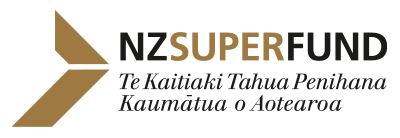Reference portfolio
We use a Reference Portfolio, which is set by the Guardians’ Board, to benchmark the performance of our actual investment portfolio and the value we are adding through our active investment strategies.
The Reference Portfolio was introduced in 2010. It is a shadow or notional portfolio of passive, low-cost, listed investments suited to the Fund’s long-term investment horizon and risk profile. Capable of meeting the Fund’s objectives over time, it has an 80:20 split between growth and fixed-income investments and its foreign currency exposures are 100% hedged to the New Zealand dollar.
The reference portfolio is therefore a very clear and ‘pure’ way for the Guardians to:
- estimate the Fund’s expected returns;
- benchmark active (value add) investment returns net of all costs; and
- be clear on the ‘hurdles’ for active investments.
Our aim, as an active investor, is to add more value after all costs to the fund than the reference approach would do, using strategies based on the Fund’s natural advantages as a long-term, sovereign investor with low liquidity requirements.
For example, we:
- invest in a range of illiquid assets – including infrastructure, private equity and timber;
- undertake extensive due diligence and manager monitoring to ensure we choose the most effective and skilled investment managers;
- aim to implement our trades and investments as efficiently as possible; and
- periodically adjust our exposure to various asset classes within our actual portfolio, using our long-term horizon to take advantage of market volatility. This is called ‘Strategic Tilting’.
These activities bring a higher expected return and/or offer diversification benefits for the Fund, albeit with more complexity and cost.
The Reference Portfolio approach encourages thinking on the underlying economic drivers of risk, returns and correlations (e.g. growth, inflation, liquidity and agency risks) rather than asset classes
per se. Allocating capital through these lenses can therefore improve the true level of diversification of the Fund, relative to a more traditional Strategic Asset Allocation approach.
The Reference Portfolio also encourages greater separation and delegation of value-adding activities from the Board to internal management. This allows the Board to focus on governance around the risk allocation and investment process, and allows management to focus on adding value to the portfolio.
The Reference Portfolio can change over time, for example, if:
- aspects of the Fund’s purpose or endowments (e.g. our long-term horizon) change; or
- market developments mean that a narrower or wider set of representative market exposures can be accessed passively and at a low cost; or
- our assumptions about the equilibrium risk-return attributes of asset classes change materially, so that the mix of assets in the Reference Portfolio no longer reflects what the Guardians' believe is an appropriate balance of risk and return.
Breakdown of the reference portfolio
| Asset class | Percentage (%) |
|---|---|
|
Global equities |
75 |
|
New Zealand equities |
5 |
|
Global fixed income |
20 |
|
Property* |
0 |
|
Total reference portfolio |
100 |
Last updated: September 2023
*Property had a 5% weight between July 2010 and June 2015.
